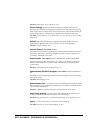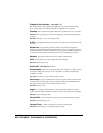
GLOSS-7
BETA DOCUMENT - PRELIMINARY & CONFIDENTIAL
Channel Associated Signaling (CAS) Also called: CAS
A type of robbed-bit signaling usually used on E1 lines.
See also: E-1 (p. G-11), robbed-bit signaling (p. G-22)
Channel Service Unit (CSU) Also called: CSU
A device located on the customer’s premises that allows hardware such as Dialogic digital
network cards to connect to digital lines installed by a digital line provider, such as a T1
lines.
See also: digital line (p. G-10), digital service unit (DSU) (p. G-10), T-1 (p. G-24)
Circuit A physical connection of computer, telephony, and network equipment over
which a telephonic conversation takes place.
CLASS Telephone An analog telephone that supports Bell Communications
Resource (Bellcore) Custom Local Area Signaling Services (CLASS) features such as
caller ID, caller ID on call waiting, and message waiting. For a list of phones that have these
features, see Strata CS Installation & Maintenance Manual.
Client A computer that requests information from a Server computer over a network.
The client runs an application that requests the information from the Server, and then
displays it in a usable format.
See also: client/Server (p. G-7), Server (p. G-22)
Client (Strata CS Program) Also called: Strata CS Client (program)
A Strata CS software application employed by users on client computers. Used to make and
receive calls, access voice mail, create contact lists, and so forth. Also used to assign
customized routing lists and greetings for specific users.
See also: client (p. G-7),
Client License A license purchased from Toshiba for each Client logged on to the
Strata CS Server. For example, with five Strata CS Client licenses you can have a
maximum of five simultaneous Client applications logged on to the Server.
Client/Server A type of computing that splits processing between client computers
and Server computers over a network. Client computers manage the user interface, make
requests over the network to Server computers, and perform local processing of data.
Server computers process client requests and return only the results needed. Before
client/Server computing, clients were dumb terminals that displayed data that was
processed by a mainframe or minicomputer.
See also: client (p. G-7), Server (p. G-22)
Codec The technology that compresses and decompresses voice signals for
transmission over an IP network. When an IP link is established, both devices negotiate a
mutually supported codec that will be used. Since one codec may be preferable to another


















